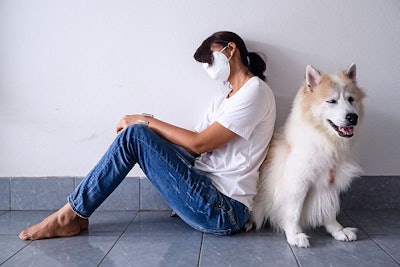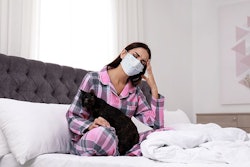
On March 19, Today.com posted a live poll asking readers if they’re stocking up on pet food during the coronavirus (COVID-19) outbreak. As of March 25, 803 people (including yours truly) had voted, with 47% saying they’re just shopping normally for pet food, 35% responding yes and that they have “tons of food” and 18% somewhere in between. (The poll was posted within an article, “Here’s what pet stores are doing during coronavirus closures,” by Kerry Breen.)
Obviously, this is not a scientific survey. A better measure of how pet owners are approaching pet care during the COVID-19 outbreak may be actual sales data: In its most recent earnings call, General Mills chairman and CFO Jeff Harmening said that for the week ending March 7, the company’s retail sales were up “low double digits,” including for its Blue Buffalo pet food lines, and he anticipated results for the week ending March 14 to be even higher.
We have also received anecdotal reports of other pet food companies experiencing significant sales increases as coronavirus cases have continued to multiply worldwide. The representative of a small company told me its sales as of March 20 were 89% higher than the previous week’s, with Amazon sales up 96% week over week and 59% for the month to date.
Mark Kalaygian, publishing director and editor-in-chief of Pet Business magazine, wrote that in his anecdotal conversations with pet store owners around the U.S., they reported sales spikes of 15-30% in March. Some believe they may be taking business from online retailers that are experiencing delivery delays; pet owners don't want to wait even a few days to receive their pets' food.*
To me, those types of short-term increases smack of stocking up on pet food, a sign that pet owners are as anxious about being able to provide for their pets during this crisis while also worrying about their own well-being.
Consumers turning to brands, online retailers
While the pet food sales jumps may be a temporary blip before leveling out, we know that most pet owners will continue to do their best to feed their pets, even if their incomes suffer. Though the economic downturn resulting from the pandemic may have no direct comparison, how pet food fared during the Great Recession last decade may provide some clues. Sales declined, but not to the level that other product categories suffered. Harmening said he believes pet food demand in the U.S. will remain robust, despite economic hardship due to the crisis.
In terms of consumers overall, 40% of Americans and 33% of Canadians are worried about how the pandemic will affect their lifestyles, according to data Mintel just released from its Global COVID-19 Tracker. Perhaps more telling, new GfK research shows 73% of consumers say how companies react and handle the unfolding crisis will have an impact on future purchase decisions, and 85% of Gfk respondents indicated the virus is impacting their shopping behaviors, according to Bob Wheatley, CEO of Emergent, a brand marketing agency. This data presages a “significant, and likely lasting, migration to e-commerce channels,” he wrote.
Indeed, with pet food, we already seeing that shift, plus resulting delays in delivery from the likes of Chewy and Amazon. Meanwhile, pet stores, though just very recently added to the list of essential businesses released by the U.S. Cybersecurity and Infrastructure Security Agency (part of the Department of Homeland Security), were already operating under that assumption. According to Breen of Today.com, Pet Valu and Petco representatives said their stores around the U.S. are remaining open, even in areas under closure mandates or shelter-in-place orders.*
Pet food companies can provide information, reassurance
Regardless of their pet food purchasing habits now, pet owners, just like all people, are definitely feeling anxiety over the COVID-19 pandemic and, as the GfK data indicates, looking to companies and brands. The GfK research implies consumers are closely watching what companies do, Wheatley wrote, “paying attention to your behaviors and communication” as part of their increasing need for emotional support and preparedness.
For pet food companies, that means finding ways to communicate with your customers to help assure them in these uncertain, even frightening times. Ideas include:
- Provide information, as close to real time as possible, on your website and social media about where your pet food products can be found, especially if data indicates long delivery delays with Chewy, Amazon or other online retailers.
- Share even more information than you normally do on your safety measures, not only for ensuring the safety and quality of your products but also the health and well-being of your employees.
- Also provide tips and insights on how pet owners can keep their pets healthy during the crisis, including links to organizations with information on whether dogs and cats are at risk of contracting COVID-19 (they’re not, as far as current studies show) – plus fun, beneficial ways to spend the extra time they’re now enjoying with their pets.
- Finally, and thankfully, people tend to pull together and want to help others in times of crisis. In this case, that probably means helping fellow pet owners and other pets, so provide links to local or national organizations that are coordinating such aid.
Here are good examples of information currently being shared (a very small, rather random sample; I’m sure there are many others):
- Purina’s open letter to its customers about how it’s approaching the crisis – it refreshingly does not follow the boilerplate communications so many companies are sending out now and also links to Petfinders, which suggests ways to help other pet owners and pets.
- Royal Canin has helpful information on keeping pets healthy, the susceptibility of pets to COVID-19 and other reassuring tidbits.
- NomNomNow uses transparent, fairly frank language to assure customers they can still get their pets’ food delivered, that the company’s employees are staying safe – and that there is no need to turn pets into shelters or otherwise abandon them.
- My colleague, Lindsay Beaton, also wrote about this recently, though conversely and positively, our colleague Tim Wall wrote about a recent spike in pet adoptions.
Such dichotomy seems to be the way of our world right now. Whatever you can do to help provide clarity and concrete information to your pet food customers at this time should go a long way in reassuring them and earning their loyalty for when we come out on the other side of the crisis.
*Note: This post has been updated to include the anecdotal pet retailer reports from Mark Kayalgian at Pet Business and the fact that the Cybersecurity and Infrastructure Security Agency very recently added pet stores to the list of essential businesses.
View our continuing coverage of the coronavirus/COVID-19 pandemic.


















